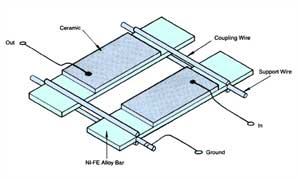Mechanical band pass receiver filter
- an overview, tutorial and information about the basics of mechanical
filters, a form of high performance fixed frequency RF filter used in many radio
communications receiver applications.
Although crystal filters are widely used as the high
performance filters in many radio receivers, mechanical filters are another
option, especially when high levels of performance are needed. They can provide
an ideal option where specific performance parameters are needed for some RF
filter applications for various radio communications applications.
Mechanical filters have been used for many years and are able
to provide excellent service at frequencies up to just under 1 MHz. These RF
filters can offer advantages over crystal filters in some instances being small,
very stable, and rugged. In fact they are not subject to deterioration due to
continuous exposure to shock and vibration, a factor that can be particularly
important in some applications. A further advantage is that these RF filters
offer low levels of intermodulation distortion, a factor that is often
overlooked in many radio receiver designs.
Principles of operation
In essence their operation is very similar to that of a
crystal, although the various functions are performed by individual components
within the RF filter. At either end of the RF filter assembly there are
transducers which convert the signals from their electrical form to mechanical
vibrations, and back again at the other end. These vibrations are applied to a
series of mechanical resonators which are mechanically resonant at the required
frequency. The resonators are mechanically coupled, typically with coupling
wires to transfer the vibrations from one section to the next. By altering the
amount of coupling between the sections and the natural frequency of each
resonator, the response of the overall unit can be tailored to meet the exact
requirements.
Types of mechanical filter
There are several types of mechanical filter. The choice of
the type depends upon the frequency in use and the application.
The first type is known as the "torsional" filter. This type
of mechanical filter uses rods that vibrate in torsion. Electrical energy is
coupled in by means of a piezoelectric ceramic transducer into torsional motion.
These filters are used for frequencies in the range from below 100 kHz to just
under 1 MHz.

Seven-resonator torsional mechanical filter
Image Courtesy Rockwell Collins
A second type of filter is known as the "bar flexural mode"
mechanical filter. This is used for low frequency designs, typically having a
centre frequency between 5 to 100 kHz and with bandwidths of .2 to 1.5 percent.

Bar flexural mode mechanical filter
Image Courtesy Rockwell Collins
Summary
Although mechanical filters are not used as widely as crystal
filters, they can nevertheless offer an excellent solution in a number of
exacting radio communications applications. In view of this, mechanical filters
are the ideal solution for many applications where high performance filters are
required at frequencies below about 700 kHz to 1MHz.
|